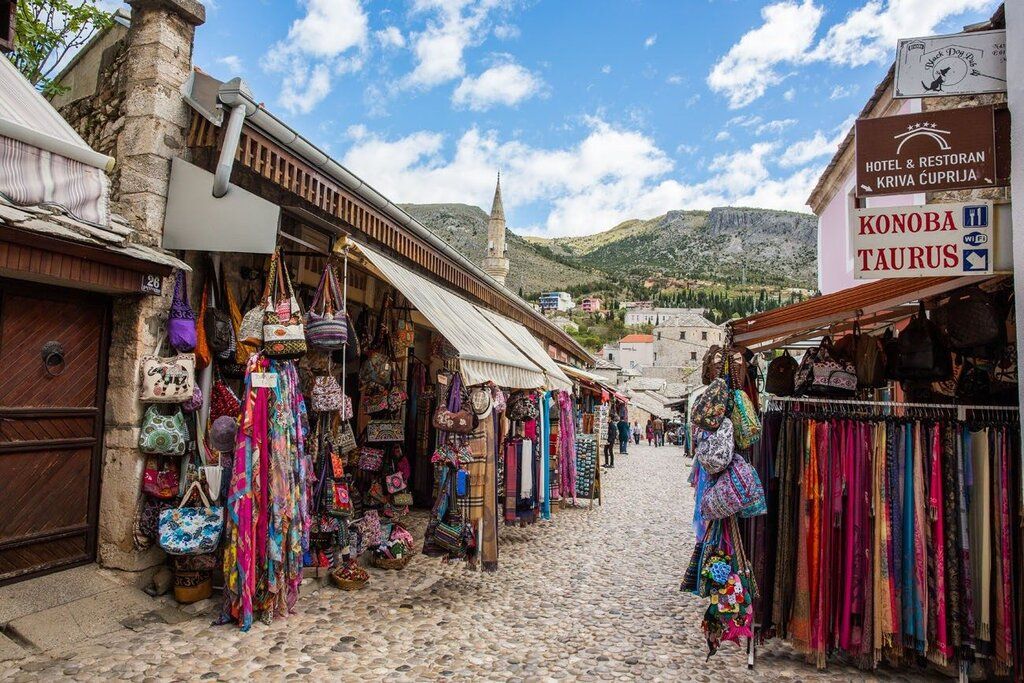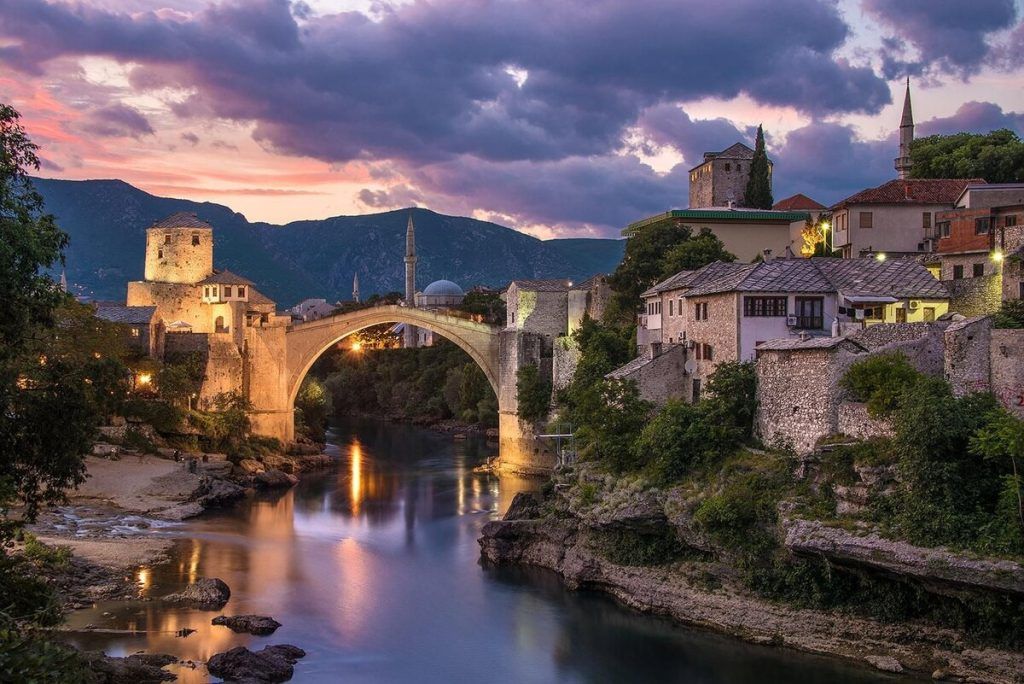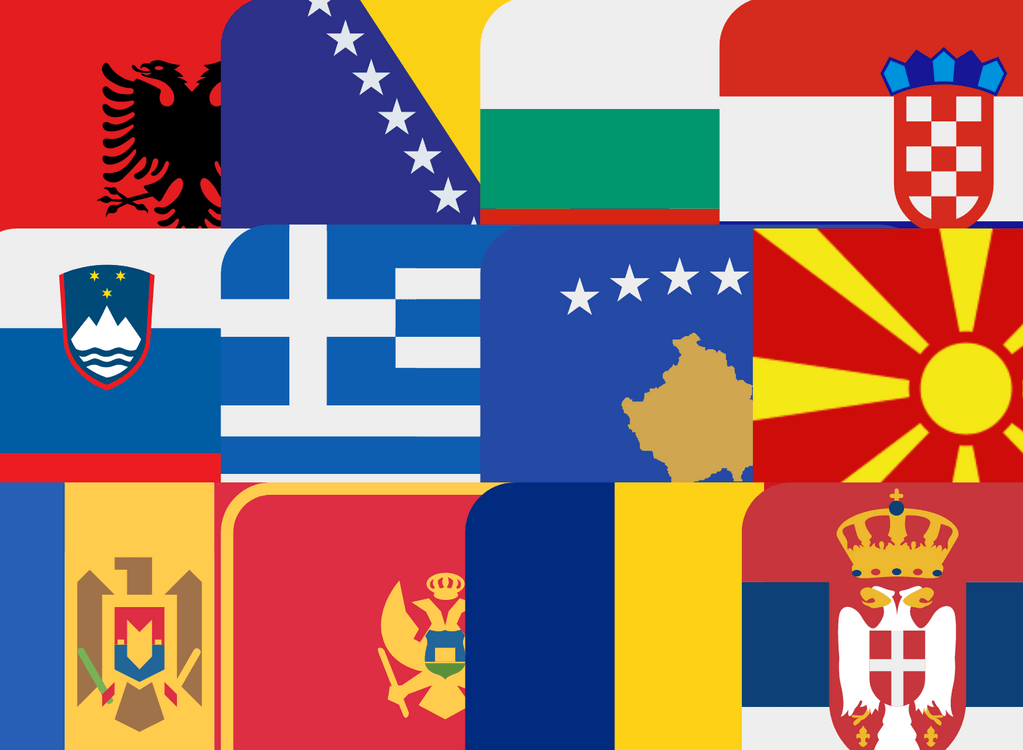Mostar, a hidden pearl in the heart of Bosnia and Herzegovina, invites travelers to immerse themselves in a journey full of history, culture and unparalleled beauty. Known worldwide for its iconic Stari Most (Old Bridge), a testament to centuries-old Ottoman architecture, this destination offers much more than just a step over the Neretva River.
Upon entering its cobbled streets, the traveler discovers the vibrant soul of a city that has been reborn from the ashes of history. Every corner of Mostar, from the ancient Kujundziluk bazaar, reminiscent of Istanbul’s most vibrant souks, to the vestiges of the 1990s war, tells a story of resilience and coexistence.
Beyond the city, nature calls for exploration with gems such as the Kravice waterfalls, offering a refuge of peace and natural beauty that contrasts with the bustle of the city. Blagaj Tekija, a dervish monastery at the foot of a cliff, complements the offering with a spiritually and visually stunning experience.
To get to Mostar, the traveler has multiple options, with car rental being the most convenient for those seeking the freedom to explore at their own pace. With scenic routes connecting Mostar to Sarajevo, Split or Dubrovnik, the trip itself becomes part of the adventure. Alternatively, buses and trains offer direct connections from Sarajevo, allowing easy and affordable access to this jewel of Bosnia and Herzegovina.
We invite the adventurous and curious to immerse themselves in the essence of Mostar, discovering its best-kept secrets and being captivated by the hospitality and cultural wealth of its inhabitants. This trip promises to be an unforgettable experience that goes beyond simple tourism, it is an invitation to live and breathe the authentic Mostar.

Main Attractions: What to See in Mostar
Mostar is not just its famous bridge. The city is full of points of interest that offer deep insight into its rich history and diverse culture. The Stari Most, a magnificent stone bridge rebuilt after its destruction in the war, remains the symbolic heart of Mostar. From here, visitors can enjoy daily shows by local divers challenging the waters of the Neretva.
Mostar’s old town, with its cobblestone streets and historic buildings, transports visitors to another era. Kujundziluk Bazaar, with its colorful craft, textile and jewelry shops, offers a vibrant and authentic atmosphere. It is the perfect place to buy souvenirs and experience local hospitality.
Another highlight is the Koski Mehmed Pasha Mosque, from whose minaret you can get a stunning panoramic view of the city and the river. Not far from there, the Museum of Herzegovina offers a comprehensive overview of regional history and culture, with exhibitions ranging from prehistory to modern times.
Architecture lovers can’t miss the Turkish House (Muslibegovic House), a restored Ottoman residence that offers an intimate look at the noble life of bygone eras. Additionally, the many cafes and restaurants along the Neretva River offer the opportunity to taste delicious Bosnian cuisine, with dishes such as cevapi and burek.
Mostar is a city that invites exploration and discovery, with every corner offering something new and fascinating. From its historical sites to its vibrant markets and culinary delights, there is something for everyone in this gem of Bosnia and Herzegovina.
Nature Excursions: Kravice Waterfalls and More
Beyond the urban charm of Mostar, the region offers impressive natural landscapes that are worth exploring. Among these, the Kravice waterfalls stand out as one of the most spectacular and popular destinations for nature lovers. Located about 40 kilometers south of Mostar, these waterfalls on the Trebižat River form a 25-meter-high natural amphitheater, creating a paradise of natural pools and lush vegetation.
Kravice waterfalls are an ideal place for swimming, picnicking or simply relaxing while listening to the sound of falling water. The environment offers designated areas for swimming, as well as basic services such as cafes and rest areas. During the summer months, the area comes alive with visitors looking to escape the heat and enjoy a refreshing natural environment. In addition, renting boats and kayaks allows you to explore the river from a different perspective, adding a touch of adventure to the visit.
Another natural destination near Mostar is Blidinje National Park, a vast protected area encompassing mountains, lakes and forests. The park is perfect for outdoor activities such as hiking, mountain biking, and bird watching. Lake Blidinje, in particular, is a picturesque spot ideal for a day of picnic or a relaxing walk along its shores.
The village of Blagaj, located just 12 kilometers from Mostar, is another essential excursion. Blagaj Tekija, a 16th-century dervish monastery, sits at the foot of an impressive cliff next to the source of the Buna River. This location not only offers a spiritual and cultural experience, but also a spectacular natural setting for photography and meditation.
For the most intrepid adventurers, rafting on the Neretva River is an exciting option. Rafting tours allow you to explore the region’s natural landscapes from the water, offering a perfect combination of adrenaline and scenic beauty. Several local companies organize excursions that are suitable for both beginners and experts.
Exploring the natural wonders around Mostar offers a unique opportunity to connect with nature and enjoy outdoor activities. From the stunning Kravice waterfalls to the serene Blidinje National Park and the spirituality of Blagaj Tekija, each excursion promises a memorable and enriching experience.
How to Get to Mostar: Transportation Tips
Getting to Mostar is a fundamental part of the adventure and there are various options to suit different preferences and budgets. The city is well connected to other major cities in Bosnia and Herzegovina and to nearby international destinations, making it easy to access this fascinating destination.
From Sarajevo: The capital of Bosnia and Herzegovina, Sarajevo, is the most common starting point for travelers heading to Mostar. The distance between Sarajevo and Mostar is approximately 130 kilometers and can be traveled by car, bus or train.
By car: Driving from Sarajevo to Mostar is a convenient option for those who want to enjoy the freedom of exploring at their own pace. The E73 (M17) highway directly connects both cities and offers scenic landscapes along the Neretva River. The trip takes around two and a half hours.
By bus: Several bus companies operate regular routes between Sarajevo and Mostar. Buses depart frequently from Sarajevo’s main bus station and the journey takes between two and a half to three hours. This option is economical and comfortable, with affordable prices and flexible schedules.
By train: The train is a scenic alternative to travel from Sarajevo to Mostar. The railway line offers spectacular views of the mountainous landscape and the Neretva River valley. Trains leave twice a day and the journey takes approximately two and a half hours. Although a slower option, the train journey is an experience in itself, with stunning scenery along the way.
From Dubrovnik and Split (Croatia): Mostar is also easily accessible from the Croatian cities of Dubrovnik and Split, making it a great option for those traveling through the Balkans.
From Dubrovnik: The distance between Dubrovnik and Mostar is approximately 150 kilometers. The car journey takes around two and a half hours, crossing the border between Croatia and Bosnia and Herzegovina. Bus services are also available, with several daily departures and a journey time of approximately three hours.
From Split: The distance between Split and Mostar is around 170 kilometers. Driving from Split to Mostar takes around three hours. Buses also operate this route, offering an affordable and convenient option with a travel time of three to four hours.
Other transportation options:
By plane: Mostar has a small airport, Mostar International Airport (OMO), which receives seasonal and charter flights, mainly from Italy and other European destinations. However, most international travelers choose to fly to Sarajevo, Dubrovnik or Split and then continue to Mostar by land.
Car rental: For those who prefer greater flexibility, car rental is an excellent option. Rental agencies are available at airports and major city centres, allowing travelers to design their own itinerary and explore the surroundings of Mostar at their own pace.
Regardless of the method of transport chosen, reaching Mostar is a journey that adds to the overall experience, offering panoramic views and the opportunity to immerse yourself in the natural beauty of the Balkans. Once in Mostar, the city offers a unique combination of history, culture and nature that promises to captivate every visitor.

Discovering the Gastronomy of Mostar
Mostar’s gastronomy is a reflection of its rich history and cultural diversity. The flavors of Bosnian cuisine are influenced by Ottoman, Mediterranean and Central European traditions, offering a unique culinary experience that delights all palates.
Typical dishes:
Cevapi: This is perhaps the most well-known and loved dish of Bosnia and Herzegovina. These are small minced meat sausages, usually beef or lamb, served in a flatbread called lepinja, accompanied by onion, sour cream and sometimes ajvar (a red pepper paste).
Burek: A savory pastry filled, commonly with minced meat, but also available in versions with cheese (sirnica), spinach (zeljanica) or potato (krompiruša). This dish is a popular choice for breakfast or as an appetizer.
Begova Corba: This thick soup, also known as bey soup, is a comforting treat made with chicken, vegetables, and okra. It is perfect to start a traditional Bosnian meal.
Japrak: Grape leaves stuffed with meat and rice, similar to the dolmas of Mediterranean cuisine. This dish is an example of the Ottoman influence in local gastronomy.
Desserts:
Baklava: This famous dessert of layers of filo dough filled with walnuts and dipped in syrup is a testament to Mostar’s Ottoman heritage. Although it originates from Türkiye, the Bosnian version is less sweet but equally delicious.
Tufahija: Cooked apples stuffed with walnuts and covered with syrup and whipped cream. This dessert is a real delight for those who have a sweet tooth.
Hurmašice: Syrup-soaked cookies, often flavored with lemon or orange, that melt in the mouth.
Drinks:
Bosnian Coffee: Coffee in Mostar is not just a drink, it is a cultural experience. Prepared in a similar way to Turkish coffee, it is served in small cups with a glass of water and often accompanied by a sweet. The coffee ceremony is an opportunity to socialize and enjoy a quiet moment.
Rakija: This strong, clear liquor, similar to brandy, is distilled from different fruits, the most common being plum (šljivovica). It is a traditional drink that is consumed at celebrations and family gatherings.
Where to Eat in Mostar:
Traditional Restaurants: Restaurants such as Šadrvan and Tima-Irma in the center of Mostar offer a varied menu of local dishes, in environments that reflect the cultural heritage of the region. Here, diners can enjoy authentic meals while soaking in the city’s historic atmosphere.
Cafes and Bars: Mostar has a wide variety of cafes and bars where you can enjoy a cup of Bosnian coffee or a glass of rakija. Places like Café de Alma and Coco Loco are popular with locals and tourists alike.
Local Markets: Visiting local markets such as the Kujundziluk bazaar not only offers an opportunity to buy fresh products and crafts, but also to taste local snacks and fast foods.
Exploring the cuisine of Mostar is an adventure in itself. From traditional dishes that tell stories of historical influences to modern cafes that offer contemporary delicacies, the city offers a rich variety of flavors that will delight all visitors.
